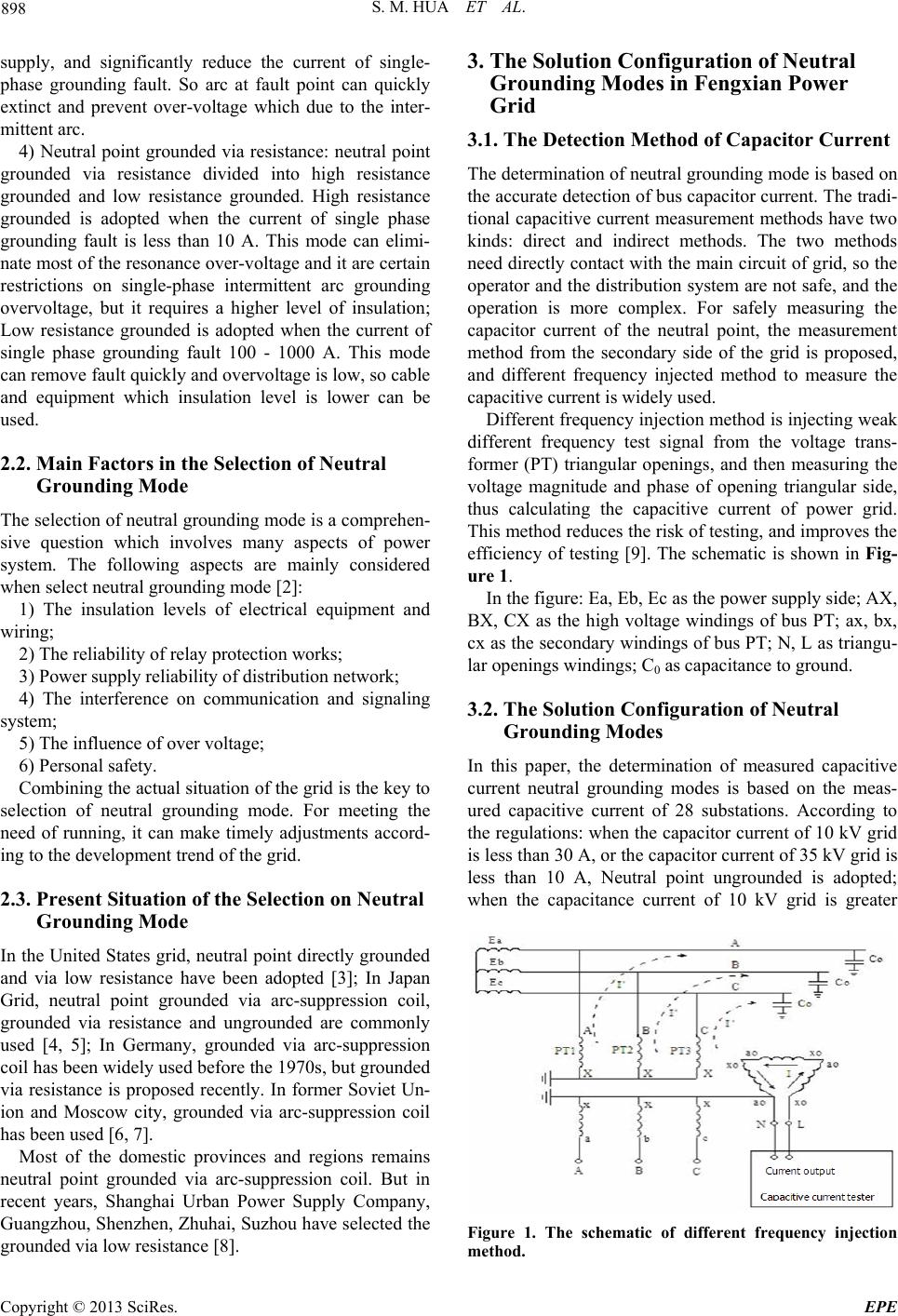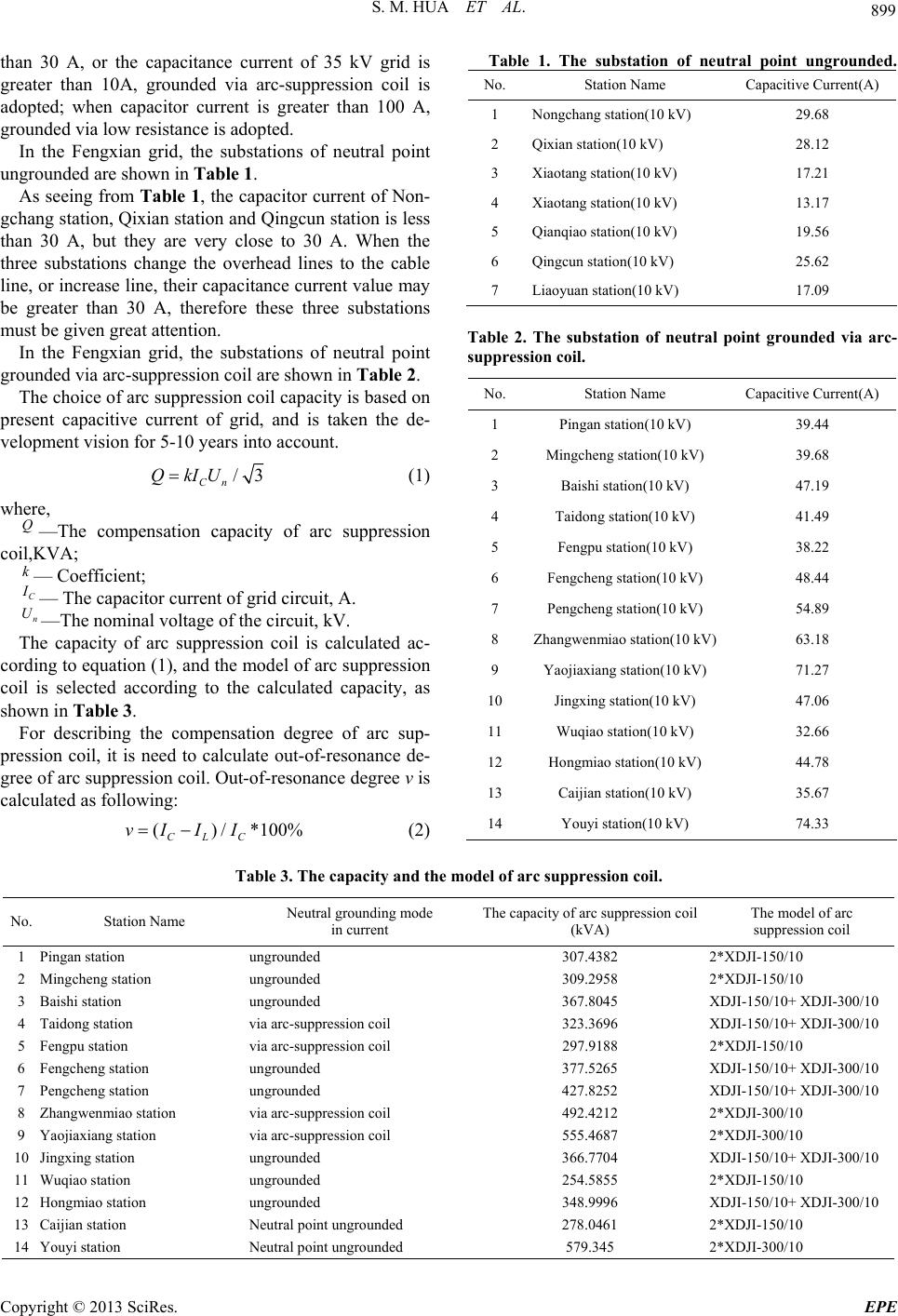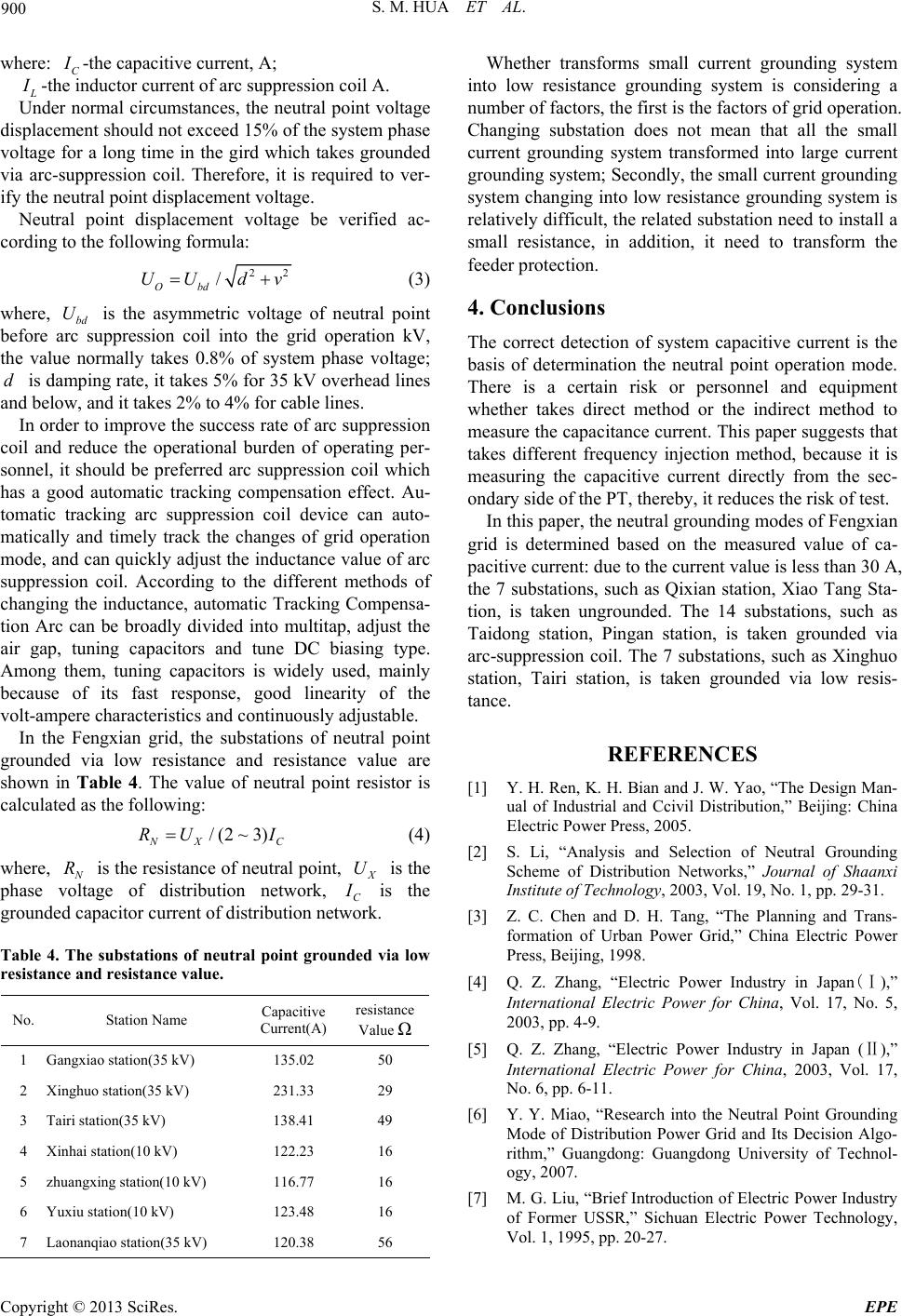Paper Menu >>
Journal Menu >>
 Energy and Power Engineering, 2013, 5, 897-901 doi:10.4236/epe.2013.54B172 Published Online July 2013 (http://www.scirp.org/journal/epe) The Research on Neutral Grounding Scheme of Fengxian 35 kV and 10 kV Power Grid Siming Hua1, Hua Zhang1, Feng Qian1, Chunjie Chen2, Meixia Zhang2 1Dispatch Control Center of the Fengxian Supply Power, Shanghai, China 2Shanghai University of Electric Power, Shanghai, china Email: hsm2217@139.com Received March, 2013 ABSTRACT Combined with actual situation of Fengxian power Supply Company, the neutral grounding modes of Fengxian 35 kV and 10 kV power grid are studied in the paper. The different frequencies injected method is used to measure the capaci- tive current of Fengxian 28 substations, and the neutral grounding modes of the 28 substations are determined based on the measured values of capacitive current. Keywords: Neutral Grounding Mode; Different Frequency Injected Method; Capacitive Current; Arc Suppression Coil; Low Resistance 1. Introduction Shanghai fengxian power grid has eight 35 kV trans- former substations and forty 10 kV transformer substa- tions. The neutral grounding modes of these substations include: ungrounded, grounded via arc-suppression coil and grounded via low resistance. Among them, 21 sub- stations such as Qixian station are use ungrounded, 7 substations such as Taidong station are use grounded via arc-suppression coil, and 20 substations such as Zugang station are use grounded via low resistance. With the increasing of cable line in fengxian 35 kV and 10 kV distribution systems, the capacitive current of single-phase grounding fault is growing, which brings new topic to the choice of neutral grounding mode in Shanghai fengxian distribution network. In this paper, according to the measured value of capacitive current, the 28 substations which use ungrounded and grounded via arc-suppression coil were studied. 2. The Analysis of Neutral Grounding Mode in Distribution Network 2.1. Common Neutral Grounding Modes There have four common ground modes in power system: the neutral point directly grounded, grounded via arc- suppression coil, grounded via low resistance and un- grounded. Among them, ungrounded and grounded via l high resistance are called as non-effectively grounded system, the neutral point directly grounded and grounded via low resistance are called as effective grounded sys- tem [1]. 1) Neutral point directly grounded system: the required levels of over-voltage and power transmission equipment insulation are low in neutral-point solid ground system, thereby it can reduce the cost of equipment and line, but the current of single-phase grounding is high at the fault of single-phase grounding, which inevitably lead to the tripping of the circuit breaker and reduce supply continu- ity, thereby, it reduce supply reliability. 2) Neutral point ungrounded system: the current of single-phase grounding fault is very small in ungrounded system. It can operate with fault for some time in order to find the fault line, thus the reliability of power supply can greatly improve. And the interference with communica- tion lines is low. But it will emerge arc restricting over- voltage, thus it requires a higher level of insulation. If the line is long, grounding capacitive current will be very high that easy to form intermittent arc grounding or sta- ble arc grounding. It requires other neutral grounding modes to avoid the impact on the safe operation of power grid. 3) Neutral point grounded via arc-suppression coil: arc suppression coil is adjustable inductor coil which installs in the neutral point of grid. The inductive current be formed when single-phase ground fault occurs, which close to but direction opposite to grounded capacitor current, so that the current at fault point becomes small or close to zero. According to compensation rate, it can be divided into: under compensation, full compensation and over compensation. In the grid, the over compensa- tion widely use. When single-phase ground fault occurs, this grounding mode can improve the reliability of power Copyright © 2013 SciRes. EPE  S. M. HUA ET AL. 898 supply, and significantly reduce the current of single- phase grounding fault. So arc at fault point can quickly extinct and prevent over-voltage which due to the inter- mittent arc. 4) Neutral point grounded via resistance: neutral point grounded via resistance divided into high resistance grounded and low resistance grounded. High resistance grounded is adopted when the current of single phase grounding fault is less than 10 A. This mode can elimi- nate most of the resonance over-voltage and it are certain restrictions on single-phase intermittent arc grounding overvoltage, but it requires a higher level of insulation; Low resistance grounded is adopted when the current of single phase grounding fault 100 - 1000 A. This mode can remove fault quickly and overvoltage is low, so cable and equipment which insulation level is lower can be used. 2.2. Main Factors in the Selection of Neutral Grounding Mode The selection of neutral grounding mode is a comprehen- sive question which involves many aspects of power system. The following aspects are mainly considered when select neutral grounding mode [2]: 1) The insulation levels of electrical equipment and wiring; 2) The reliability of relay protection works; 3) Power supply reliability of distribution network; 4) The interference on communication and signaling system; 5) The influence of over voltage; 6) Personal safety. Combining the actual situation of the grid is the key to selection of neutral grounding mode. For meeting the need of running, it can make timely adjustments accord- ing to the development trend of the grid. 2.3. Present Situation of the Selection on Neutral Grounding Mode In the United States grid, neutral point directly grounded and via low resistance have been adopted [3]; In Japan Grid, neutral point grounded via arc-suppression coil, grounded via resistance and ungrounded are commonly used [4, 5]; In Germany, grounded via arc-suppression coil has been widely used before the 1970s, but grounded via resistance is proposed recently. In former Soviet Un- ion and Moscow city, grounded via arc-suppression coil has been used [6, 7]. Most of the domestic provinces and regions remains neutral point grounded via arc-suppression coil. But in recent years, Shanghai Urban Power Supply Company, Guangzhou, Shenzhen, Zhuhai, Suzhou have selected the grounded via low resistance [8]. 3. The Solution Configuration of Neutral Grounding Modes in Fengxian Power Grid 3.1. The Detection Method of Capacitor Current The determination of neutral grounding mode is based on the accurate detection of bus capacitor current. The tradi- tional capacitive current measurement methods have two kinds: direct and indirect methods. The two methods need directly contact with the main circuit of grid, so the operator and the distribution system are not safe, and the operation is more complex. For safely measuring the capacitor current of the neutral point, the measurement method from the secondary side of the grid is proposed, and different frequency injected method to measure the capacitive current is widely used. Different frequency injection method is injecting weak different frequency test signal from the voltage trans- former (PT) triangular openings, and then measuring the voltage magnitude and phase of opening triangular side, thus calculating the capacitive current of power grid. This method reduces the risk of testing, and improves the efficiency of testing [9]. The schematic is shown in Fig- ure 1. In the figure: Ea, Eb, Ec as the power supply side; AX, BX, CX as the high voltage windings of bus PT; ax, bx, cx as the secondary windings of bus PT; N, L as triangu- lar openings windings; C0 as capacitance to ground. 3.2. The Solution Configuration of Neutral Grounding Modes In this paper, the determination of measured capacitive current neutral grounding modes is based on the meas- ured capacitive current of 28 substations. According to the regulations: when the capacitor current of 10 kV grid is less than 30 A, or the capacitor current of 35 kV grid is less than 10 A, Neutral point ungrounded is adopted; when the capacitance current of 10 kV grid is greater Figure 1. The schematic of different frequency injection method. Copyright © 2013 SciRes. EPE  S. M. HUA ET AL. Copyright © 2013 SciRes. EPE 899 than 30 A, or the capacitance current of 35 kV grid is greater than 10A, grounded via arc-suppression coil is adopted; when capacitor current is greater than 100 A, grounded via low resistance is adopted. In the Fengxian grid, the substations of neutral point ungrounded are shown in Table 1. As seeing from Table 1, the capacitor current of Non- gchang station, Qixian station and Qingcun station is less than 30 A, but they are very close to 30 A. When the three substations change the overhead lines to the cable line, or increase line, their capacitance current value may be greater than 30 A, therefore these three substations must be given great attention. In the Fengxian grid, the substations of neutral point grounded via arc-suppression coil are shown in Table 2. The choice of arc suppression coil capacity is based on present capacitive current of grid, and is taken the de- velopment vision for 5-10 years into account. /3 Cn QkIU (1) where, Q—The compensation capacity of arc suppression coil,KVA; k— Coefficient; C I — The capacitor current of grid circuit, A. n U—The nominal voltage of the circuit, kV. The capacity of arc suppression coil is calculated ac- cording to equation (1), and the model of arc suppression coil is selected according to the calculated capacity, as shown in Table 3. For describing the compensation degree of arc sup- pression coil, it is need to calculate out-of-resonance de- gree of arc suppression coil. Out-of-resonance degree v is calculated as following: () /*100% CLC vIII (2) Table 1. The substation of neutral point ungrounded. No. Station Name Capacitive Current(A) 1 Nongchang station(10 kV) 29.68 2 Qixian station(10 kV) 28.12 3 Xiaotang station(10 kV) 17.21 4 Xiaotang station(10 kV) 13.17 5 Qianqiao station(10 kV) 19.56 6 Qingcun station(10 kV) 25.62 7 Liaoyuan station(10 kV) 17.09 Table 2. The substation of neutral point grounded via arc- suppression coil. No. Station Name Capacitive Current(A) 1 Pingan station(10 kV) 39.44 2 Mingcheng station(10 kV) 39.68 3 Baishi station(10 kV) 47.19 4 Taidong station(10 kV) 41.49 5 Fengpu station(10 kV) 38.22 6 Fengcheng station(10 kV) 48.44 7 Pengcheng station(10 kV) 54.89 8 Zhangwenmiao station(10 kV) 63.18 9 Yaojiaxiang station(10 kV) 71.27 10 Jingxing station(10 kV) 47.06 11 Wuqiao station(10 kV) 32.66 12 Hongmiao station(10 kV) 44.78 13 Caijian station(10 kV) 35.67 14 Youyi station(10 kV) 74.33 Table 3. The capacity and the model of arc suppression coil. No. Station Name Neutral grounding mode in current The capacity of arc suppression coil (kVA) The model of arc suppression coil 1 Pingan station ungrounded 307.4382 2*XDJI-150/10 2 Mingcheng station ungrounded 309.2958 2*XDJI-150/10 3 Baishi station ungrounded 367.8045 XDJI-150/10+ XDJI-300/10 4 Taidong station via arc-suppression coil 323.3696 XDJI-150/10+ XDJI-300/10 5 Fengpu station via arc-suppression coil 297.9188 2*XDJI-150/10 6 Fengcheng station ungrounded 377.5265 XDJI-150/10+ XDJI-300/10 7 Pengcheng station ungrounded 427.8252 XDJI-150/10+ XDJI-300/10 8 Zhangwenmiao station via arc-suppression coil 492.4212 2*XDJI-300/10 9 Yaojiaxiang station via arc-suppression coil 555.4687 2*XDJI-300/10 10 Jingxing station ungrounded 366.7704 XDJI-150/10+ XDJI-300/10 11 Wuqiao station ungrounded 254.5855 2*XDJI-150/10 12 Hongmiao station ungrounded 348.9996 XDJI-150/10+ XDJI-300/10 13 Caijian station Neutral point ungrounded 278.0461 2*XDJI-150/10 14 Youyi station Neutral point ungrounded 579.345 2*XDJI-300/10  S. M. HUA ET AL. 900 where: C I -the capacitive current, A; L I -the inductor current of arc suppression coil A. Under normal circumstances, the neutral point voltage displacement should not exceed 15% of the system phase voltage for a long time in the gird which takes grounded via arc-suppression coil. Therefore, it is required to ver- ify the neutral point displacement voltage. Neutral point displacement voltage be verified ac- cording to the following formula: 22 / Obd UU dv (3) where, bd is the asymmetric voltage of neutral point before arc suppression coil into the grid operation kV, the value normally takes 0.8% of system phase voltage; is damping rate, it takes 5% for 35 kV overhead lines and below, and it takes 2% to 4% for cable lines. U d In order to improve the success rate of arc suppression coil and reduce the operational burden of operating per- sonnel, it should be preferred arc suppression coil which has a good automatic tracking compensation effect. Au- tomatic tracking arc suppression coil device can auto- matically and timely track the changes of grid operation mode, and can quickly adjust the inductance value of arc suppression coil. According to the different methods of changing the inductance, automatic Tracking Compensa- tion Arc can be broadly divided into multitap, adjust the air gap, tuning capacitors and tune DC biasing type. Among them, tuning capacitors is widely used, mainly because of its fast response, good linearity of the volt-ampere characteristics and continuously adjustable. In the Fengxian grid, the substations of neutral point grounded via low resistance and resistance value are shown in Table 4. The value of neutral point resistor is calculated as the following: /(2~3) N X RU IC (4) where, N R is the resistance of neutral point, X is the phase voltage of distribution network, C U I is the grounded capacitor current of distribution network. Table 4. The substations of neutral point grounded via low resistance and resistance value. No. Station Name Capacitive Current(A) resistance Value Ω 1 Gangxiao station(35 kV) 135.02 50 2 Xinghuo station(35 kV) 231.33 29 3 Tairi station(35 kV) 138.41 49 4 Xinhai station(10 kV) 122.23 16 5 zhuangxing station(10 kV) 116.77 16 6 Yuxiu station(10 kV) 123.48 16 7 Laonanqiao station(35 kV) 120.38 56 Whether transforms small current grounding system into low resistance grounding system is considering a number of factors, the first is the factors of grid operation. Changing substation does not mean that all the small current grounding system transformed into large current grounding system; Secondly, the small current grounding system changing into low resistance grounding system is relatively difficult, the related substation need to install a small resistance, in addition, it need to transform the feeder protection. 4. Conclusions The correct detection of system capacitive current is the basis of determination the neutral point operation mode. There is a certain risk or personnel and equipment whether takes direct method or the indirect method to measure the capacitance current. This paper suggests that takes different frequency injection method, because it is measuring the capacitive current directly from the sec- ondary side of the PT, thereby, it reduces the risk of test. In this paper, the neutral grounding modes of Fengxian grid is determined based on the measured value of ca- pacitive current: due to the current value is less than 30 A, the 7 substations, such as Qixian station, Xiao Tang Sta- tion, is taken ungrounded. The 14 substations, such as Taidong station, Pingan station, is taken grounded via arc-suppression coil. The 7 substations, such as Xinghuo station, Tairi station, is taken grounded via low resis- tance. REFERENCES [1] Y. H. Ren, K. H. Bian and J. W. Yao, “The Design Man- ual of Industrial and Ccivil Distribution,” Beijing: China Electric Power Press, 2005. [2] S. Li, “Analysis and Selection of Neutral Grounding Scheme of Distribution Networks,” Journal of Shaanxi Institute of Technology, 2003, Vol. 19, No. 1, pp. 29-31. [3] Z. C. Chen and D. H. Tang, “The Planning and Trans- formation of Urban Power Grid,” China Electric Power Press, Beijing, 1998. [4] Q. Z. Zhang, “Electric Power Industry in Japan(Ⅰ),” International Electric Power for China, Vol. 17, No. 5, 2003, pp. 4-9. [5] Q. Z. Zhang, “Electric Power Industry in Japan (Ⅱ),” International Electric Power for China, 2003, Vol. 17, No. 6, pp. 6-11. [6] Y. Y. Miao, “Research into the Neutral Point Grounding Mode of Distribution Power Grid and Its Decision Algo- rithm,” Guangdong: Guangdong University of Technol- ogy, 2007. [7] M. G. Liu, “Brief Introduction of Electric Power Industry of Former USSR,” Sichuan Electric Power Technology, Vol. 1, 1995, pp. 20-27. Copyright © 2013 SciRes. EPE  S. M. HUA ET AL. 901 [8] B. P. Wang, “Research of Neutral Point Grounded Mode for Medium Voltage Network,” Shandong: China Uni- versity of Petroleum (east China), 2009. [9] Y. Yang, “The Capacitive Current Test Methods of Neu- tral not Grounding,” Yunnan Electric Power, Vol. 39, No. 3, 2011, pp. 20-22. Copyright © 2013 SciRes. EPE |

